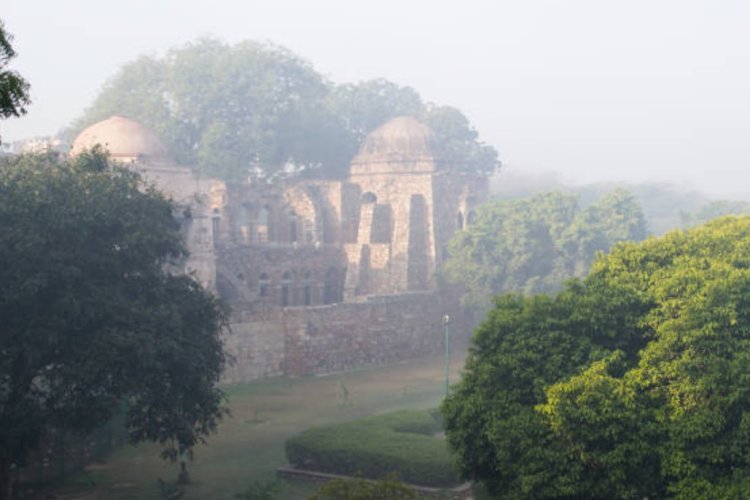
Delhi air pollution crisis: Every winter, Delhi is enveloped in a dense, grey haze that brings flight delays, school closures, and a public health emergency. This recurring “fifth season” of smog is no longer an atmospheric event — it is a governance crisis in plain sight. Despite decades of policy plans and court orders, the capital’s toxic air persists, exposing a deeper malaise: India’s fragmented environmental governance and weak institutional coordination.
The failure is not of awareness or law. It is the inability of institutions to act in concert, where multiple agencies pursue overlapping mandates but no one bears full responsibility. Delhi’s smog reflects not just pollution but paralysis.
READ | Delhi smog crisis: Pollution vs India’s climate ambition
Mapping Delhi’s air quality crisis
The data reveals how grave the problem has become. A joint study by the Energy and Resources Institute (TERI) and the Automotive Research Association of India (ARAI) found Delhi’s average winter PM2.5 concentration at 160–170 micrograms per cubic metre — eight times the national safe limit. PM10 levels often touch 300 μg/m³, making Delhi one of the most polluted capitals in the world.
Pollution sources are varied and interlinked. Road and construction dust account for about 30–40% of particulate matter. Vehicular emissions add another 15–30%, while industry and power generation contribute 10–15%. Biomass and household fuel burning add 10%, and agricultural stubble burning along with regional inflows make up 15–25%, particularly during October and November.
The State of Global Air 2024 report estimates that air pollution causes more than two million premature deaths in India annually. The economic loss runs into billions of rupees due to respiratory diseases, lost productivity, and hospitalisation.
Why October and November see deadliest pollution levels
Delhi’s air quality plunges dramatically every autumn due to a toxic mix of factors. Crop residue burning peaks in Punjab and Haryana after the paddy harvest, releasing vast plumes that drift toward the city. Temperature inversion traps these pollutants close to the ground, while low wind speeds prevent their dispersal. Firecrackers during festivals, heavy vehicular congestion, and ongoing construction add to the burden.
Each of these factors is well known. Yet, the lack of preventive planning turns the annual smog crisis into an avoidable disaster. India’s air pollution problem thus becomes a case study in predictable neglect.
Delhi air pollution crisis: Anatomy of governance failure
Delhi’s air pollution is a symptom of deeper institutional dysfunction. Multiple agencies share authority, but none owns the outcome. The Central Pollution Control Board (CPCB) sets national standards, but enforcement rests with state-level bodies such as the Delhi Pollution Control Committee (DPCC), which lacks manpower and capacity. The Commission for Air Quality Management (CAQM) was set up to coordinate across states but has limited binding powers. The National Green Tribunal (NGT) issues judicial directives but cannot ensure sustained compliance. Meanwhile, state governments—Delhi, Punjab, Haryana, and Uttar Pradesh—pursue short-term political interests.
The result is administrative gridlock. Each winter, the Delhi government blames Punjab and Haryana for stubble burning; the northern states counter that Delhi’s vehicles and industries are to blame. The Centre issues advisories, the courts intervene, and the public gasps for air. Political theatre replaces cooperation.
Policy by panic and weak enforcement
Delhi’s response to pollution is largely reactive. When air quality crosses emergency levels, authorities halt construction, close schools, or enforce temporary schemes like odd-even vehicle rationing. These are stopgap measures that treat symptoms, not causes. The Graded Response Action Plan (GRAP) kicks in only after air quality deteriorates sharply—by then, the damage is done.
A 2023 audit by the Comptroller and Auditor General (CAG) revealed alarming lapses in India’s vehicle emission monitoring: inadequate testing, insufficient staffing, and poor compliance with clean-fuel norms. Without rigorous penalties or real-time data, enforcement remains toothless.
Behind every smog episode lie vested interests—real estate developers, construction lobbies, and transport unions—who resist reform. Agrarian distress, too, drives farmers to burn residue rather than adopt costly alternatives. Meanwhile, the poor bear the brunt, breathing the city’s exhaust firsthand.
Towards a clean-air governance model
Delhi’s smog crisis demands more than seasonal outrage. It calls for a structural reform of India’s environmental governance. What the city needs is an integrated airshed approach, where policy and enforcement work across state boundaries and not within political silos. Real-time pollution data must be made public to ensure transparency and accountability.
Reforms in farm subsidies to discourage residue burning, incentives for electric and hybrid transport, and curbs on uncontrolled construction can help tackle the problem at its roots. Citizen engagement—through public monitoring and behavioural change—is equally critical.
The 2016 Odd-Even experiment showed that compliance is possible when governance, enforcement, and citizen cooperation align. Such coordination must become systemic rather than seasonal.
Delhi’s smog is a parable of failed governance. Each year, the same headlines return, the same emergency measures are announced, and the same haze descends. The crisis highlightsthe need for political consensus and institutional unity.
Breathing clean air is not a privilege—it is a constitutional right under Article 21, the right to life. Until India’s institutions learn to breathe together, its capital will continue to choke on the failures of its own systems.
Shariq Us Sabah is an independent economist and author.
